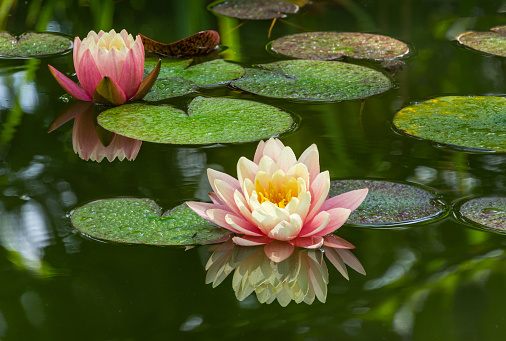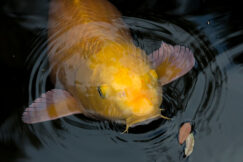Cultivating lovely water lilies is as simple as growing their terrestrial counterparts. Follow a few simple procedures, and fragrant blossoms will soon flourish.
What Exactly Is a Water Lily?
Water lily is the popular name for blooming plants of the Nymphaeaceae botanical family. Not to be confused with lotus blossoms (Nelumbo), water lilies are floral pond plants that grow from tubers sown in the soil in a body of water.
They develop thick green leaves known as lily pads, which float on the water’s surface. Water lily blossoms come in a range of yellows, pinks, whites, and reds, depending on the species.
The water plants inspired Impressionist painter Claude Monet, who created approximately 250 oil paintings of the species Nymphaea.
Water Lilies’ Function and Drawbacks
Water lilies have a variety of pleasant colors and are lovely while in bloom, but they also provide the following benefits for ponds:
They spread roots that may be encouraged to attract waste particles from the pond, increasing water quality and benefiting fish health.
Water lily leaves spread across the pond’s surface, creating shaded areas for fish to use while also preventing the growth of green algae, which flourishes in water exposed to sunlight. In this regard, the lilies once again contribute to the preservation of water quality.
In terms of drawbacks, a water lily that is too huge for a pond will not appear especially nice.
A water lily that is too tiny, on the other hand, will appear understated, depending on the desired impact. Many water lily species expand quickly, overwhelming the pond and its owner with the necessary maintenance labor.
Getting the Right Balance
A good beginning point for most ponds is to arrange water lilies in such a way that they will grow:
should cover no more than one-third of the pond’s surface area in the appropriate section of the pond and the right quantity in sunlight places to provide the needed spread of flowers while in bloom, preferably in the required color
The second factor to consider is the depth of the pond’s water, which will influence the type of water lily required. For example, water lilies should not be placed on a shallow ledge with less than nine inches of water depth because they will die or overrun the surrounding region.
Most water lilies are planted in pots filled with aquatic compost and covered with gravel or grit to give weight to stabilize the plant.
With this in mind, the potential buyer can determine how much effort will be involved in seating the containers.
These stages will give you a clear concept of your goal before making final decisions, and you will be much better informed when it comes time to discuss the needs with the provider.
Some Common Water Lilies’ Characteristics
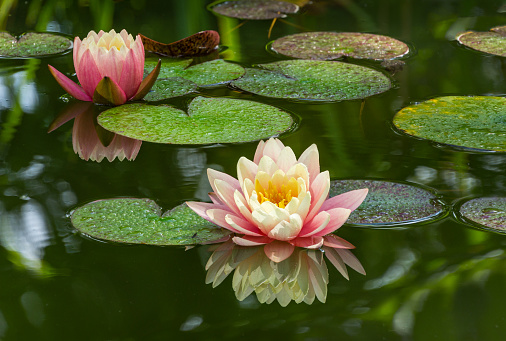
The list below highlights the selection criteria for a handful of the most popular water lilies. Of course, they will develop beyond the listed depths; however, these are thought to be the best for the greatest growth and balance:
- Nymphaea pygmaea helvola is a little yellow hardy lily with a pond depth of 9 to 12 inches, yellow flowers, and leaves up to 36 inches long.
- Nymphaea rose is an airy, elegant lily with a pond depth of 12 to 18 inches, a pink blossom, and a leaf size of up to 60 inches.
- Nymphaea James Brydon – fast-growing, pond depth of 18 to 24 inches, deep rose bloom color, leaf size up to 48 inches.
- Nymphaea caerulea is a common pond plant with a depth of 18 to 24 inches, blue flowers, and leaves up to 18 inches long.
These are only four of the hundreds of different species of water lilies.
Water lily plants are classified into two types:
Hardy
Hardy varieties are ideally suited to northern locations where the water freezes in the winter. Hardy specimens’ roots will emerge next spring as long as they are below the freezing point of the water.
Tropical
Tropical water lilies cannot thrive in cold water and must be taken indoors in all but the hottest climates during the winter. As a result, many farmers treat them as annuals and replant them yearly.
Otherwise, take them from the pond, clean them up, and keep them in a cool basement in a pail of damp sand before the first freeze. There are two types of tropical water lily plants: day bloomers and night bloomers.
White night bloomers appear stunning with just moonlight illuminating them, but blues, purples, reds, and pinks are quite difficult to see in the dark. Therefore, these colors should be avoided unless the pond is lighted by artificial light at night.
Pests and Diseases of Waterlilies
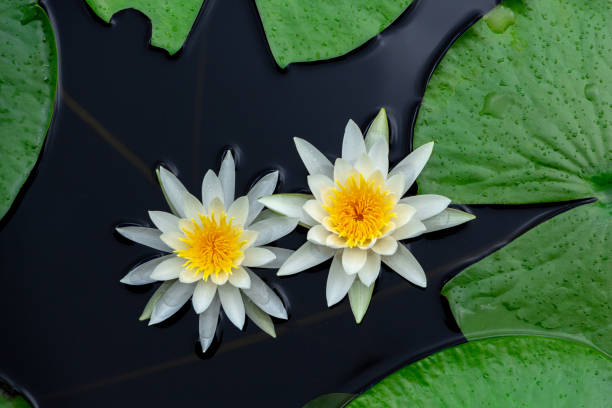
Pests
- Dogs
- Raccoons
- Koi
- Aphids
- China Mark Moth
- Leaf Mining Midges
A simple fence should assist in keeping koi, dogs, and raccoons at bay. Make the lilies unavailable to the fish if koi are consuming them. Make a safe pond for them to swim in, or wrap chicken wire around each pot.
Electric fences and pest deterrents that spray a surprise stream of water when a motion detector is triggered can be used to control dogs and raccoons.
Hand selecting insect pests or using an aquatic safe insecticidal soap might be used to control them. These goods should be available at local hardware stores.
Diseases
- Crown rot
Preventing illness is the greatest approach; once it begins to grow, it may swiftly take over. Begin with only healthy stock and feed each plant well. Remove any dead or decaying foliage or blossoms. Remove any soft patches from tubers and roots.
The second soak in a separate tub or clean trash can with potassium permanganate (4-6 Tbsp in 12-13 gallons of water for 1-2 hours) might help cure or prevent crown rot. Plants that have been infected should most likely be culled and killed so that they do not infect others.
Waterlily General Care and Growing Conditions
Waterlilies are a sun-loving aquatic plant; to guarantee optimal bloom and continuous flushes of flowers, ensure that each plant receives at least 6-8 hours of direct sunshine daily.
Water lily roots demand nutrient-rich clay-based soils for the plants to flourish to their full potential.
Then, according to the label, a suitable fertilizer for blossoming aquatic plants should be administered.
Fertilizer tablets put beneath the soil in the water lily container will aid in the prevention of algae blooms caused by excess nitrogen runoff from some liquid fertilizers. Before using any fertilizer, always ensure that it is fish safe.
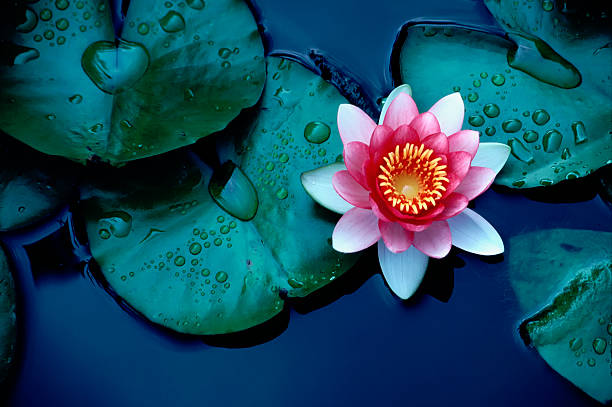
How to Make a Good Waterlily Soil Mix at Home
- 1 Part Sand
- 3 Parts Soil
- Enough gravel to cover the top 2-3 inches of the planting
All of the components should be fully combined. This soil mixture is also suitable for various clay-loving aquatic plants. If you’re using soil instead of clay, cover the top few inches with sand or pea gravel to keep soil debris from rising from the pot and muddying up the pond water.
How to Miniaturize a Waterlily
Plant the lily in a tiny container, such as a disposable plastic cup.
When the lily outgrows its pot, remove it and clip away any extra root and leaf development.
Repot in new soil and use new fertilizer tablets. When too much foliage accumulates over time, pinch off any undesired or yellowing leaves and fading blossoms.
Planting Waterlily
Waterlilies thrive from mid-to-late spring to mid-summer. Plants thrive best in aquatic planting baskets, and plants purchased from aquatic centers are usually pre-planted in one and ready to submerge in water. If not, select the appropriate size for the plant’s size and vitality.
Remove any old or broken leaves and blossom buds, as well as any extremely long roots. Fill the basket with unfertile loamy soil or, even better, aquatic planting compost, ensuring the plant’s crown is at soil level. Add a layer of washed pea shingle to the compost surface.
Water the compost well and allow any excess water to drain before throwing it in the pond. Then carefully immerse the plant in water so that 10-25cm (4-10in) of water covers the crown and the leaves float on the surface, depending on the size of the plant.
The ultimate planting depth should be specified on the plant’s label. If not, inquire before you buy. Place the basket on top of bricks or a similar elevated platform to achieve the right depth.
Lower the basket as the plants develop until it reaches their full planting depth.
Small kinds can be cultivated in big ponds by supporting them on a high platform.
Water Lily Maintenance
Water lilies are simple to care for once they’ve been planted. In truth, most take little maintenance other than splitting them every three or four years to renew them and prevent them from expanding into undesirable locations.
Growing Water Lily quick tips
- As the blooms and leaves fade, remove them.
- Regular pruning is required.
- Once established, it is quite minimal maintenance.
- Avoid overcrowding your pond with aquatic vegetation. They may develop fast in warm conditions, compete with one another, and must be thinned down.
- It must be moist at all times. Excessive dryness might cause dormancy or death.
- If growing in a pot to immerse in a pond or water garden, it is sometimes preferable to grow in soil or garden loam rather than potting mix.
- During the warmer months, there is a lot of growth—plant rhizomes or divisions in the spring and summer.

